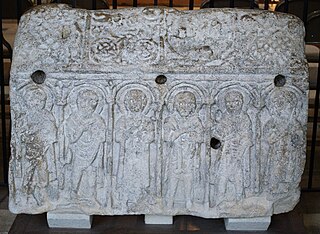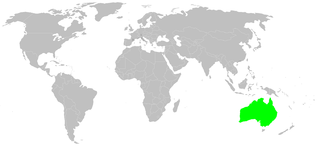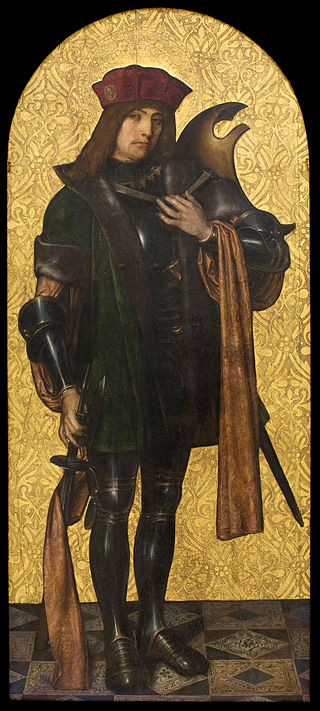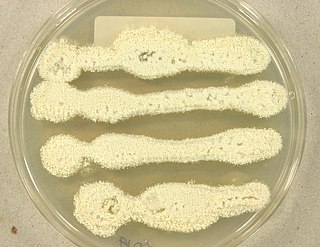
The white woodpecker is a South American species of woodpecker native to the wooded grasslands of Suriname, French Guiana, Brazil, Bolivia, Paraguay, Uruguay and Argentina. It is a bright white bird with black wings and a distinctive small bright yellow eye patch. The IUCN has rated it as a "least-concern species".

Medeshamstede was the name of Peterborough in the Anglo-Saxon period. It was the site of a monastery founded around the middle of the 7th century, which was an important feature in the kingdom of Mercia from the outset. Little is known of its founder and first abbot, Sexwulf, though he was himself an important figure, and later became bishop of Mercia. Medeshamstede soon acquired a string of daughter churches, and was a centre for an Anglo-Saxon sculptural style.

Phryganoporus candidus, also known as the foliage web spider, is a small, subsocial jumping spider endemic to Australia. On average, they are 6–10 mm long and are a mottled brown colour, covered in silvery grey hair. They typically reside in arid and semi-arid locations, building their nests in various trees, bushes, and other plant-life. They have a mutualistic relationship with Acacia ligulata, and therefore prefer to build their nests in these trees.

Candidus was a commander of the Theban Legion. The Theban Legion was composed of Christians from Upper Egypt. He is venerated as a Christian saint and martyr.
Candidus (Bruun) of Fulda was a Benedictine scholar of the ninth-century Carolingian Renaissance, a student of Einhard, and author of the vita of his abbot at Fulda, Eigil.

Hugh Candidus was a monk of the Benedictine monastery at Peterborough, who wrote a Medieval Latin account of its history, from its foundation as Medeshamstede in the mid 7th century up to the mid 12th century.
Candidus was the name given to the Anglo-Saxon Wizo or Witto by Alcuin, whose scholar he was and with whom he went in 782 to Gaul. He is author of several philosophical texts wrongly attributed by earlier scholars to the benedictinian monk Brun Candidus of Fulda, the author of the vita of Abott Eigil of Fulda. But recent research into the manuscript tradition furnishing clear evidence attested the authorship of Candidus Wizo, the learned disciple of Alcuin. Based on his deep knowledge of the works of Saint Augustine of Hippo he tried to give proof of god's existence, to demonstrate that the incorporeal nature of god is conceivable only by means of the spiritual eye and excludes any possibility of viewing him by means of the corporeal eyes, and to elucidate the problem of the incarnation explaining its need by the weakness of the human cognition. At the palace school he was tutor to Gisla, the sister, and Rodtruda, the daughter of Charlemagne. When Alcuin went to Tours (796), Candidus was his successor as master of the palace school. Alcuin's esteem for Candidus is shown by his dedicating his commentary on Ecclesiastes to his friends Onias, Fredegisus, and Candidus.
Eigil was the fourth abbot of Fulda. He was the nephew and biographer of the abbey's founder and first abbot Saint Sturm. We know about Eigil primarily from the Latin Life that the monk and teacher of Fulda, Candidus Bruun composed about him after his death.

The silky sifaka is a large lemur characterized by long, silky, white fur. It has a very restricted range in northeastern Madagascar, where it is known locally as the simpona. It is one of the rarest mammals on Earth. The silky sifaka is one of nine sifaka species, and one of four former subspecies of diademed sifaka (P. diadema). Studies in 2004 and 2007 compared external proportions, genetics, and craniodental anatomy supporting full species status, which has generally been accepted.
Gyrwas was the name of an Anglo-Saxon population of the Fens, divided into northern and southern groups and recorded in the Tribal Hidage; related to the name of Jarrow.

Saint Candidus is a painting by Ayne Bru, conserved at the National Art Museum of Catalonia.

Neoptychodes is a genus of flat-faced longhorn beetles in the subfamily Lamiinae.
Tatberht was an eighth century Anglo-Saxon saint, abbot and contemporary of Bede.

Aspergillus candidus is a white-spored species of fungus in the genus Aspergillus. Despite its lack of pigmentation, it is closely related to the most darkly-pigmented aspergilli in the Aspergillus niger group. It is a common soil fungus worldwide and is known as a contaminant of a wide array of materials from the indoor environment to foods and products. It is an uncommon agent of onychomycosis and aspergillosis. The species epithet candidus (L.) refers to the white pigmentation of colonies of this fungus. It is from the Candidi section. The fungi in the Candidi section are known for their white spores. It has been isolated from wheat flour, djambee, and wheat grain.
Neoptychodes cosmeticus is a species of beetle in the family Cerambycidae. It was described by Martins and Galileo in 1996. It is known from Ecuador and Colombia.
Neoptychodes cretatus is a species of beetle in the family Cerambycidae. It was described by Henry Walter Bates in 1872. It is known from Nicaragua, Costa Rica and Panama.
Neoptychodes hondurae is a species of beetle in the family Cerambycidae. It was described by White in 1858.
Tiberius Julius Candidus Marius Celsus was a Roman senator who lived during the Flavian dynasty. Contemporary sources, such as the Fasti Ostienses, the Acta Arvalia and a letter of Pliny the Younger, refer to him as Tiberius Julius Candidus. He was twice consul.
Candidus Isaurus was an Eastern Roman historian. His work, written in Greek, is known only from fragments.







